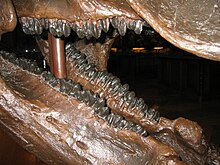Description[edit]
Individual Triceratops are estimated to have reached about 7.9 to 9.0 m (26.0–29.5 ft) in length, 2.9 to 3.0 m (9.5 to 9.8 ft) in height,[14][15] and 6.1–12.0 tonnes (13,000–26,000 lb) in weight.[16] The most distinctive feature is their large skull, among the largest of all land animals. The largest known skull (specimen MWC 7584, formerly BYU 12183) is estimated to have been 2.5 metres (8.2 ft) in length when complete,[5] and could reach almost a third of the length of the entire animal.[12] It bore a single horn on the snout, above the nostrils, and a pair of horns approximately 1 m (3.3 ft) long, with one above each eye.[17] In 2010, paleontologists revealed a fossil (named "Yoshi's Trike" MOR 3027) with 115 cm long horn cores, housed and displayed at the Museum of the Rockies in Montana. [18][19] To the rear of the skull was a relatively short, bony frill, adorned with epoccipitals in some specimens. Most other ceratopsids had large fenestrae in their frills, while those of Triceratops were noticeably solid.[20]
The skin of Triceratops was unusual compared to other dinosaurs. Skin impressions from an as-yet undescribed specimen show that some species may have been covered in bristle-like structures, similar to the more primitive ceratopsian Psittacosaurus.[21]
Limbs[edit]
Triceratops species possessed a sturdy build, with strong limbs, short hands with three hooves each, and short feet with four hooves each.[10] Although certainly quadrupedal, the posture of these dinosaurs has long been the subject of some debate. Originally, it was believed that the front legs of the animal had to be sprawling at angles from the thorax, in order to better bear the weight of the head.[13] This stance can be seen in paintings by Charles Knight and Rudolph Zallinger.Ichnological evidence in the form of trackways from horned dinosaurs, and recent reconstructions of skeletons (both physical and digital) seem to show that Triceratops and other ceratopsids maintained an upright stance during normal locomotion, with the elbows flexed and slightly bowed out, in an intermediate state between fully upright and fully sprawling (as in the modern rhinoceros).[10][22][23][24]



No comments:
Post a Comment